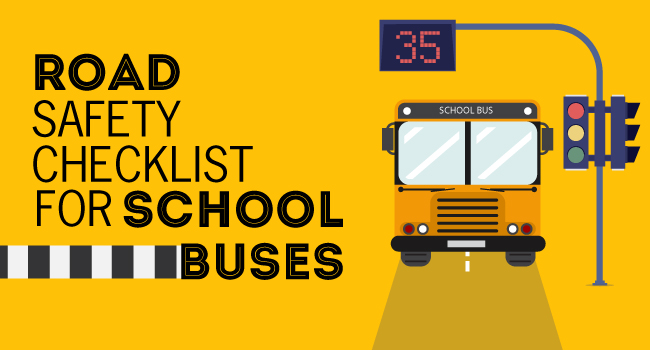Schools have always been implementing all essential measures to ensure the safety of the students. However, in a hurry to implement the measures, they happen to miss out something at the end, thus leading to fatalities. The best way to tackle this issue is by creating a road safety checklist for school buses.
Here is what you must include in your checklist:
1. Braking Systems of School Bus
Here are the steps to check the efficiency of braking systems:
Step 1: Check whether the air pressure is at maximum while starting the school bus and also make sure that air pressure remains constant when you switch off the vehicle engine
Step 2: Press and hold the brake pedal in such a way that it drops a little and then it remains constant
Step 3: If the pressure goes on decreasing, it indicates that the braking system is having an air leak
Step 4: Start the school bus and pump the brake till the pressure becomes half of the braking system. The low pressure indicator must produce a buzzing sound as well as a flashing light
Step 5: Make sure that air pressure adjusts and recharge to the maximum
Step 6: Braking system should be checked on a weekly basis
2. Tyres of School Bus
- Tyre pressure should be adjusted according to manufacturer's specification, that is, based on the load being carried by the vehicle
- Tread pattern of tyre must be consistent and tread depth must not be less than 1mm
- Tyres must have same size and type on the same isle
- Ensure that dual wheel tyres never make wall contact, never have same size, and its air pressure must be within specified limits
- It is essential that tyres on a dual wheel makes ground contact on a flat surface especially, when the vehicle is unladen
- Examine the lumps, cracks and bulges in the side walls of school bus tyres. Also, make sure that there is no hindrance between dual wheels
3. Steering of Bus
- Steering must function freely from lock to lock
- Ensure that the power steering reservoir is full
- Check for stone damage and leaks in pipes
- School bus undercarriage should be checked routinely for any oil or fluid leakage
- Ensure that the steering wheel of the school bus does not have any crack in it
4. Windscreen, Windows and Wiper blades of School Bus
- Check whether the windscreen, wiper blades and windows are in proper condition. Immediately repair if it is clouded or cracked anywhere as it hinders the driver's view of the road
- Windscreen and windows must be clearly recognised as safety glass
- Make sure that side glass of the school bus is not cracked, which may obstruct the driver's view
- Ensure that at least one wiper in front of the bus works properly
5. Lights
- Check whether the headlights, front and rear park lamps, tail lamp, stop lamp, hazard lamp and reverse lamps of the school bus work
- Ensure that all peripheral devices like reflectors are in working condition
6. Bodywork
- Make sure that bolt-on accessories like bumpers, mirrors, etc. are not damaged
- Ensure that the overhead storage racks are not overloaded
- Emergency exits must be made visible
If school bus safety is your priority, ensure that all the above mentioned things are checked before the school bus starts its journey.
“Safety is more important than convenience”
